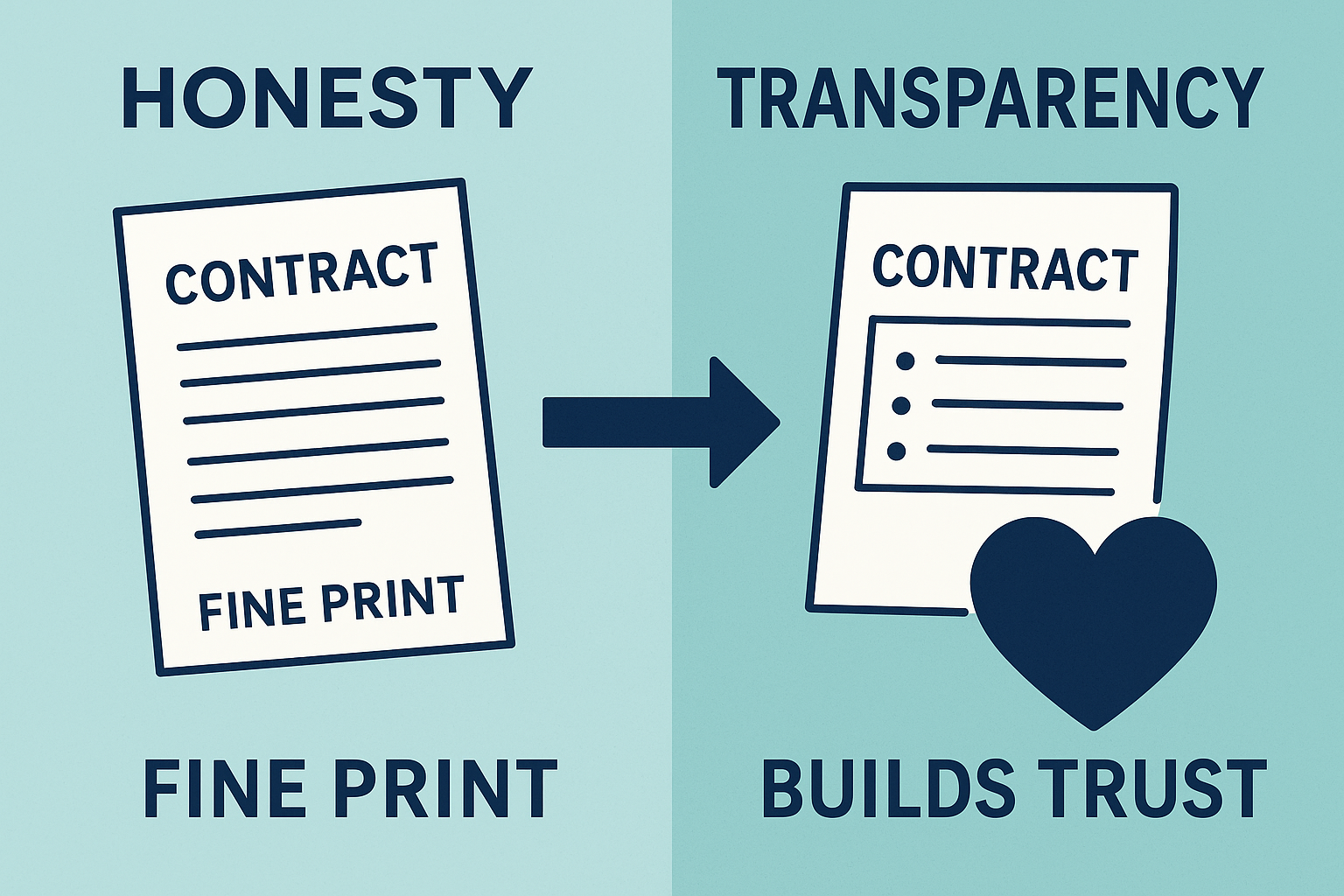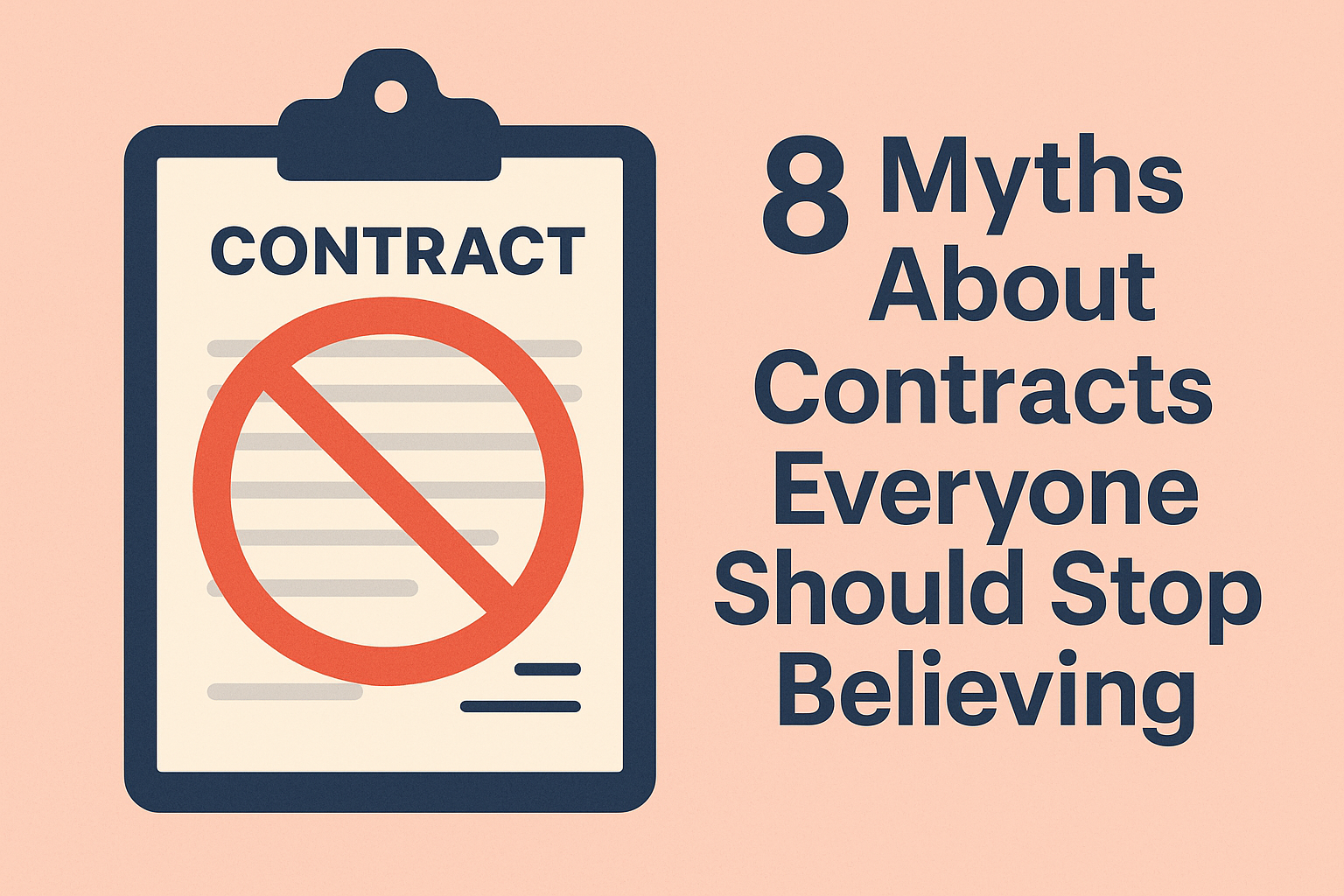Unclear contracts are a major source of customer complaints and legal disputes. When terms are buried in legalese or dense fine print, people often sign without truly understanding what they’ve agreed to. The result? Surprise fees, unmet expectations, and a flood of grievances. For example, the UK’s Financial Ombudsman received over 165,000 complaints in 2022–23, and roughly one in three were resolved in the customer’s favor – not due to intentional wrongdoing by the business, but because customers genuinely hadn’t understood the terms. This isn’t just a customer service headache; it’s a compliance and reputational risk. The good news is that by designing contracts for clarity and understanding, organizations can dramatically reduce these issues. Clarity in contracts means fewer “I didn’t know that” surprises and a stronger defense if complaints do arise. Below, we outline seven best practices in contract design that improve user understanding – and explain how each practice helps to cut down on complaints and disputes.
What this blog contains:
- Use Plain Language
- Start with a Summary of Key Points
- Organize Information with Clear Structure
- Emphasize and Reinforce Critical Terms
- Offer Multiple Formats for Clarity
- Make the Agreement Interactive (Confirm Understanding)
- Design with Inclusivity and Accessibility in Mind
- Conclusion
1. Use Plain Language
Plain language is the cornerstone of contract clarity. This means writing contracts in everyday, straightforward terms – avoiding legal jargon, convoluted sentences, and unnecessary complexity. Instead of “The lessee shall remit pecuniary compensation on a monthly basis,” say “You will make monthly payments.” Plain language ensures that the average person (who likely reads at about a 7th–8th grade level) can actually understand the obligations and rights in the agreement. The benefits of plain language are backed by decades of research and real-world results. Readers not only comprehend plain English contracts better, but also prefer them and are more likely to read them in the first place. In fact, studies compiled by Professor Joseph Kimble found that even judges and lawyers strongly favor plain language – it improves understanding, speeds up reading, and increases compliance.
For businesses, using plain language directly translates into fewer misunderstandings and disputes. When terms are clear, customers are far less likely to later say “I didn’t realize what that meant” or claim they were misled. This prevents complaints before they happen. There’s also a concrete operational payoff: one case study showed that after a government agency rewrote a single complex letter in plain English, calls from confused recipients dropped from about 1,110 to just 200 – an over 80% reduction in inquiries. Similarly, an industry study noted that simply using clearer language can cut customer support calls by around 30% in regulated sectors. Fewer clarification calls and complaints mean lower support costs and less time spent firefighting issues. In short, plain language helps ensure customers know exactly what they’re agreeing to, so they won’t feel tricked or surprised later on. It builds trust, and it keeps both the client and the company on the same page – literally and figuratively.
2. Start with a Summary of Key Points
No matter how clear the wording, a lengthy contract can overwhelm readers if they have to sift for the important details. That’s why it’s a best practice to begin with a concise summary of the key terms and obligations. Present the most crucial points up front – the “need-to-know” items such as the core offer, main fees or payments, critical dates (like termination or renewal dates), and any significant limitations or responsibilities. This summary (often called a “Key Facts” section or contract overview) gives readers a mental roadmap before they dive into the full legal text. It ensures that even skimmers catch the big points early. Regulators favor this approach too; for instance, financial and insurance industries often provide a one-page summary or fact box precisely because it improves consumer understanding.
Starting with a summary helps reduce disputes by making sure nothing important is missed. A customer is much less likely to complain “Nobody told me about X fee” when that fee was prominently summarized at the top of the agreement. Essentially, this practice front-loads the critical information to prevent nasty surprises. It’s a form of “preemptive clarity.” Users who might not read every word will at least grasp the headline terms. Think of how news articles start with a bold headline and a synopsis – contracts benefit from the same treatment. By designing the document to say “Here’s the deal in a nutshell” at the outset, you greatly decrease the odds of misunderstandings. Clients feel more informed from the get-go, which boosts their confidence in the agreement. And if a dispute ever arises, the business can point to that clear summary as evidence that the key points were communicated openly. In the end, a well-crafted summary sets the tone for transparency and mutual understanding, heading off confusion before it can take root.
3. Organize Information with Clear Structure
How information is presented is just as important as the words themselves. A contract should be structured for readability, meaning it’s broken into logical sections with clear headings, short paragraphs, and bullet-point lists where appropriate. Wall-of-text contracts in tiny font are a recipe for confusion – they cause reader fatigue and important details get lost in the noise. Instead, good design practice is to make the document easily scannable. Use descriptive headings for each topic (e.g., “Payment Terms,” “Cancellation Policy,” “Your Responsibilities”) so that someone can navigate and locate specific information quickly. Bullet points or tables are great for listing obligations or fees, rather than burying them in long sentences. Adequate white space and readable fonts also greatly improve comprehension, especially for longer agreements.
Why does structure matter for reducing complaints? Because most readers don’t actually read word-for-word – they scan. Research by the Nielsen Norman Group famously found that 79% of web users scan text rather than read it in full. The same is true for contracts: if customers are skimming, a well-structured contract will guide their eyes to the crucial points. Clear headings ensure they don’t overlook an entire section. Bullet points make key duties or limitations stand out. For example, instead of hiding a penalty fee in the middle of a dense paragraph, setting it as a bullet under “Fees” makes it far more likely the client will notice and understand it. This directly prevents disputes; a customer who sees “Late payment fee: £50” listed plainly is less likely to later protest that charge. Additionally, a coherent structure aids internal teams and regulators in reviewing the contract, since everything is organized logically. In summary, a clean layout and logical flow act like a map for the agreement – preventing miscommunication by making sure everyone can find and absorb the information they need without frustration.
4. Emphasize and Reinforce Critical Terms
Even with good structure, it’s wise to call extra attention to the most important terms – and repeat them at key moments. Emphasizing critical information can be done through visual cues and through strategic repetition. Visually, this means highlighting or bolding key phrases, using color or icons for important warnings, or setting important provisions in a separate text box or table. For instance, if a certain clause could be a potential pain point (say, an early termination fee or an auto-renewal clause), it shouldn’t be hidden in fine print. Make it stand out on the page. Some companies use a bold notice or a shaded box to flag “Important: By signing, you acknowledge X.” This level of emphasis ensures that readers can’t gloss over it by accident.
Reinforcement goes hand-in-hand with emphasis. Repetition is a powerful tool for memory and clarity – cognitive science calls it the “spacing effect,” meaning information is retained better when presented multiple times. In a contract context, you might introduce a key point in the summary, explain it fully in the body, and then reiterate it in a final review section or before the signature line. For example, a loan agreement might summarize the repayment term as “12 months” up front, detail the schedule in the terms, and then have the signer confirm “I understand this loan must be repaid within 12 months.” Hearing (or seeing) it more than once makes it far more likely the client truly registers the information. This reduces “I didn’t realize that” scenarios dramatically. In practice, reinforcing key terms has proven benefits – educational research shows that repetition improves recall and understanding over time. By the time a customer finishes a well-designed agreement, they’ve seen the critical points so clearly and frequently that there’s little room for doubt. This not only prevents complaints (since the client cannot credibly claim ignorance of a term that was bolded and repeated), but it also provides strong protection if a dispute escalates. The business can demonstrate that the point in question was prominently highlighted and confirmed, underscoring that the customer was adequately informed.
5. Offer Multiple Formats for Clarity
Not everyone absorbs information best by reading static text. In today’s digital age, a contract doesn’t have to be a plain document – leveraging multiple formats can greatly enhance understanding. Many people are visual or auditory learners. By providing alternative ways to explain the agreement (such as a short video overview, audio clips, infographics, or even interactive charts), you cater to different learning styles and preferences. For example, some modern agreement platforms let users watch a 2-minute animated video summarizing the contract’s key points, alongside the written document. Others offer an audio narration of the terms for those who prefer listening. Visual aids like iconography or flowcharts can simplify complex processes (imagine an icon timeline showing “Step 1: You sign up → Step 2: Service begins → Step 3: You can cancel after 12 months”). These formats aren’t just gimmicks – they truly improve comprehension. Research in education and psychology has found that when people engage multiple senses or modes (visual, auditory, textual), they understand and remember information better. It keeps them more focused and engaged than text alone.
The result of offering information in multiple formats is fewer misunderstandings and thus fewer disputes. A customer who might gloss over a written paragraph might pay closer attention to a friendly explainer video or a clear diagram. By repeating the same message in different ways, you also reinforce the content (tying back to the prior point about repetition). Importantly, multi-format communication makes your contract more inclusive – someone with lower literacy can listen to an explanation in plain speech, and a busy or visually fatigued person can watch an animation that distills the points. There have been real examples of success here: companies that added video summaries or visual highlights to their customer agreements saw drops in questions and an increase in customer satisfaction, because people “got it” the first time. From a compliance perspective, providing information in various forms also demonstrates you took reasonable steps to ensure understanding (which regulators love to see). Overall, using multiple formats turns a dry contract into a more accessible conversation. It reduces the chances that a customer will later say “I didn’t catch that detail,” because you presented that detail in more than one way.
6. Make the Agreement Interactive (Confirm Understanding)
A truly effective contract doesn’t just talk at the user – it engages the user in a dialogue. An emerging best practice is to build interactive elements into the agreement process to confirm understanding. What does this look like? One approach is allowing (or prompting) readers to ask questions as they review the contract. Rather than signing blindly, a user could click a little “Help” icon next to a clause to see a plain-language explanation, or submit a question that the company can answer before finalizing. Another interactive technique is adding brief checkpoints or quizzes: for example, after a critical section, asking the signer “Do you understand the obligations for maintenance? (Yes/No)” or having them tick a box that says “I understand that if I cancel early, I will pay a £100 fee.” Some advanced systems even have users do a quick summary in their own words or take a short multiple-choice quiz on key terms – not as a test, but as a mechanism to ensure they’ve processed the information.
This kind of interactivity is powerful for a few reasons. First, it catches confusion in the moment. If a client is unsure about something, an interactive contract invites them to get clarity immediately, rather than stay silent and complain later. It turns a passive reading into an active conversation, much like the “teach-back” method in healthcare where patients repeat back information – proven to improve comprehension and outcomes. Second, confirming understanding provides evidence that can protect the business. If a dispute arises, you have a record that the customer was asked to confirm specific terms (and they did), which makes it harder for them to claim ignorance. Regulators increasingly expect this kind of proof that customers were truly informed, not just handed a document. The UK’s Financial Conduct Authority, for instance, urges firms to take “reasonable steps to ensure customers understand” – interactive confirmations are exactly that. Finally, involving the user through interaction makes them feel respected and heard. It signals that the company cares about their understanding, not just about getting a signature. This boosts trust and can even turn a potentially confusing contract experience into a positive one. All together, making agreements interactive heads off misunderstandings at the pass, reducing the volume of complaints and creating a robust audit trail that your compliance team will appreciate.
7. Design with Inclusivity and Accessibility in Mind
Contract clarity isn’t one-size-fits-all – a truly clear contract is one that all readers, regardless of background or ability, can understand. Designing with inclusivity in mind means considering those who might have extra challenges with contracts: people with lower literacy, those for whom English is a second language, individuals with cognitive or learning disabilities, or simply folks not experienced in legal or financial jargon. This practice pulls together many of the earlier points (plain language, good structure, multiple formats) and elevates them to a principle: make sure everyone has a fair chance to comprehend the agreement. For example, use reader-friendly typography (large enough font, high contrast for those with visual impairments). Ensure the contract is compatible with screen readers for blind or low-vision users. Write in clear, culturally neutral language so that non-native speakers or those using translation tools can follow along. Avoid assumptions that the reader has prior knowledge of certain concepts – if necessary, include brief explanations or definitions in simple terms (a glossary or even tooltips on complex terms can help). The team behind ![]() i agree calls this approach “accessibility built in, not bolted on,” noting that traditional contracts often exclude many people by default. By contrast, an inclusive contract experience is designed from the ground up to welcome all users.
i agree calls this approach “accessibility built in, not bolted on,” noting that traditional contracts often exclude many people by default. By contrast, an inclusive contract experience is designed from the ground up to welcome all users.
The impact of inclusive, accessible design on complaints and disputes is significant. When you cater to the most vulnerable reader, you effectively improve clarity for everyone. Fewer customers will be left scratching their heads or misunderstanding something because the contract was more attuned to their needs. Consider that in the UK, about 1 in 5 adults has a literacy level at or below that of an 10-year-old child – if you only write contracts for college reading levels, you alienate a large chunk of your audience (and likely generate complaints when those folks inevitably get confused). By aiming for simplicity and inclusion, you prevent those misunderstandings. Moreover, regulators are increasingly focused on outcomes for all consumer demographics, including vulnerable customers. Demonstrating that your contracts are user-friendly for people with lower comprehension skills or disabilities can help satisfy obligations under consumer protection rules (and avoid regulatory disputes or claims of unfair treatment). In essence, inclusive design is preventive care: it reduces the chances that any group of customers will disproportionately lodge complaints because they couldn’t grasp the agreement. It also enhances your reputation – customers notice when a company makes the effort to communicate clearly and accessibly, and they reward that with trust and loyalty. Fewer complaints, fewer churned customers, and fewer regulatory issues all flow from designing agreements that every reader can understand.
Conclusion
Complaints and disputes aren’t an inevitable part of doing business – they are often a symptom of poor communication. By applying these best practices in contract clarity, organizations can transform the customer experience from confusion to confidence. A contract designed for understanding leads to informed consent: when a customer says “ ![]() i agree,” it genuinely means “I understand.” The payoff is a win-win. Customers feel respected, empowered, and fairly treated, resulting in higher satisfaction and fewer grievances. Meanwhile, companies see concrete benefits: lower complaint volumes, less time spent resolving disputes, and better compliance outcomes. When a complaint does arise, a clearly designed contract becomes your best defense – you can show that the information was conveyed plainly, prominently, and even confirmed by the client. This not only mitigates legal risk but also positions your brand as honest and trustworthy.
i agree,” it genuinely means “I understand.” The payoff is a win-win. Customers feel respected, empowered, and fairly treated, resulting in higher satisfaction and fewer grievances. Meanwhile, companies see concrete benefits: lower complaint volumes, less time spent resolving disputes, and better compliance outcomes. When a complaint does arise, a clearly designed contract becomes your best defense – you can show that the information was conveyed plainly, prominently, and even confirmed by the client. This not only mitigates legal risk but also positions your brand as honest and trustworthy.
In a world where attention is scarce and legal fine print is everywhere, clarity stands out as a competitive advantage. Designing agreements for understanding – using plain language, smart organization, emphasis, multiple media, interactivity, and inclusivity – is not just a nice ethical choice but a strategic one. It builds trust from the outset and fortifies your relationship with customers and regulators alike. As one industry expert succinctly put it, ensuring “I agree” really means “I understand” is the key to fewer complaints and better outcomes for all. By following the best practices above, businesses can turn confusing contracts into clear, fair conversations, and in doing so, dramatically reduce the friction and costs that come from miscommunication. In the end, clarity isn’t just about avoiding complaints – it’s about creating agreements that set the foundation for a stronger, more positive partnership between a company and its clients.
References
Internal Links (I agree resources):-
 i agree – Better Understanding, Fewer Complaints and Disputes (explains why misunderstandings cause complaints and how clear communication prevents them) – i-agree.io/reduce-complaints-and-disputes
i agree – Better Understanding, Fewer Complaints and Disputes (explains why misunderstandings cause complaints and how clear communication prevents them) – i-agree.io/reduce-complaints-and-disputes -
 i agree Blog – “Plain Language, Fewer Problems: How Clear Contracts Reduce Complaints” (overview of how using plain language in contracts leads to fewer customer issues) – i-agree.io/blog/plain-language-fewer-problems-how-clear-contracts-reduce-complaints
i agree Blog – “Plain Language, Fewer Problems: How Clear Contracts Reduce Complaints” (overview of how using plain language in contracts leads to fewer customer issues) – i-agree.io/blog/plain-language-fewer-problems-how-clear-contracts-reduce-complaints -
 i agree Blog – “Clear Communication: The Key to Fewer Complaints and Disputes” (discusses the cost of poor communication and principles for better client understanding) – i-agree.io/blog/clear-communication-the-key-to-fewer-complaints-and-disputes
i agree Blog – “Clear Communication: The Key to Fewer Complaints and Disputes” (discusses the cost of poor communication and principles for better client understanding) – i-agree.io/blog/clear-communication-the-key-to-fewer-complaints-and-disputes -
 i agree Blog – “Reducing Legal Complaints: Why Better Client Understanding is Your Best Defence” (emphasizes informed consent and communication design as protection against disputes) – i-agree.io/blog/reducing-legal-complaints-why-better-client-understanding-is-your-defence
i agree Blog – “Reducing Legal Complaints: Why Better Client Understanding is Your Best Defence” (emphasizes informed consent and communication design as protection against disputes) – i-agree.io/blog/reducing-legal-complaints-why-better-client-understanding-is-your-defence -
 i agree – Our Principles (includes the “Accessibility built in, not bolted on” philosophy, underlining inclusive design for contracts) – i-agree.io/our-principles
i agree – Our Principles (includes the “Accessibility built in, not bolted on” philosophy, underlining inclusive design for contracts) – i-agree.io/our-principles -
 i agree – The Science Behind It (explains cognitive principles like the production effect and multimodal learning applied to contract comprehension) – i-agree.io/the-science-behind-it
i agree – The Science Behind It (explains cognitive principles like the production effect and multimodal learning applied to contract comprehension) – i-agree.io/the-science-behind-it -
 i agree – How It Works (describes the platform’s process for presenting contracts with summaries, definitions, Q&A, and voice confirmation for true understanding) – i-agree.io/how-it-works
i agree – How It Works (describes the platform’s process for presenting contracts with summaries, definitions, Q&A, and voice confirmation for true understanding) – i-agree.io/how-it-works -
 i agree – Frequently Asked Questions (answers common questions on informed consent, clarity, and compliance in the contract process) – i-agree.io/frequently-asked-questions
i agree – Frequently Asked Questions (answers common questions on informed consent, clarity, and compliance in the contract process) – i-agree.io/frequently-asked-questions
- Business Insider – 91% of people don’t read online terms: Summary of a Deloitte study showing the vast majority of consumers accept terms without reading them, highlighting the importance of making agreements understandable Link
- Cooley Law School (Joseph Kimble) – Benefits of Plain Language: Describes numerous studies demonstrating how plain language in business and government communication improves comprehension, reduces inquiries, and saves money (e.g. an 80% drop in calls after simplifying a letter) Link
- Nielsen Norman Group – How Users Read on the Web: Research showing that 79% of users scan text instead of reading line-by-line, supporting the need for clear headings and highlighted key points for effective communication Link
- The Week (OECD Literacy Report) – UK Adult Literacy Statistics: Report noting that 1 in 5 British adults have literacy levels at or below a 10-year-old’s capability, underlining the need for contract language to be simple and accessible to the general population Link
- Sparx Literacy Stats – Average Reading Level in the US: Article stating the average American adult reads at a 7th–8th grade level (and over half of adults read below a 6th grade level), reinforcing why legal documents must be written plainly for broad understanding Link
- WebMD Ignite – Teach-Back Method Benefits: Explains how the teach-back technique (having individuals repeat information in their own words) significantly improves understanding and retention – for example, halving hospital readmission rates in one study – analogous to confirming understanding in contracts Link




